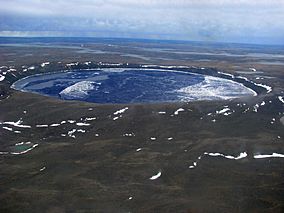Pingualuit National Park facts for kids
Quick facts for kids Parc national des Pingualuit |
|
|---|---|
|
IUCN Category II (National Park)
|
|

Pingualuit Crater
|
|
| Location | Kativik, Quebec, Canada |
| Nearest city | Kangiqsujuaq |
| Area | 1133.90 km² |
| Established | January 1, 2004 |
| Governing body | Kativik Regional Government |
Pingualuit National Park (which is Parc national des Pingualuit in French) is a huge protected area in Quebec, Canada. It covers about 1,133.90 square kilometers, which is like protecting a very large piece of land! This special park is located on the Ungava Peninsula, about 100 kilometers southwest of an Inuit village called Kangiqsujuaq.
The main reason this park was created is to protect a very unique place: the Pingualuit crater. This crater was formed by a meteorite hitting the Earth a long, long time ago.
The park is looked after by the Kativik Regional Government. This group helps make sure the park stays safe and beautiful for everyone to enjoy and learn from.
Contents
Discover Pingualuit National Park
Pingualuit National Park is a provincial park, meaning it's a protected area managed by the government of Quebec. It was officially opened on January 1, 2004. Imagine a place where nature is kept almost exactly as it was thousands of years ago! That's what this park aims to do.
The park is located in a very remote and wild part of northern Quebec. This area is known for its cold climate and unique landscapes, including vast open spaces and rocky terrain. It's a place where you can truly feel connected to the Earth's ancient past.
The Amazing Pingualuit Crater
The most famous part of Pingualuit National Park is definitely the Pingualuit crater. This crater is a "young" meteorite crater, which means it was formed more recently than many other craters on Earth. It's incredibly well-preserved, almost like it just happened!
The crater is a nearly perfect circle, about 3.4 kilometers wide. It's filled with water, forming a deep, clear lake. This lake is often called the "Crystal Eye of Nunavik" because its water is so pure and clear. Scientists study this lake because its water is some of the clearest in the world, and it can tell us a lot about the environment.
How the Crater Was Formed
The Pingualuit crater was created when a large meteorite crashed into the Earth. This impact happened about 1.4 million years ago! When the meteorite hit, it dug a huge hole in the ground, and over time, this hole filled with rainwater and melted ice, creating the lake we see today.
Because the area is so remote and has been covered by ice sheets many times since the impact, the crater has been protected from erosion. This is why it looks so fresh and well-defined, even after millions of years. It's like a natural museum of a cosmic event!
Protecting the Park's Future
Pingualuit National Park is important because it helps protect a special part of our planet. By keeping this area safe, we can learn more about Earth's history, geology, and unique ecosystems. It also helps preserve the natural beauty and cultural heritage of the region for future generations.
The Kativik Regional Government works to manage the park responsibly. They make sure that visitors can experience the park's wonders while also protecting its delicate environment. This balance helps ensure that the Pingualuit crater and its surroundings remain a pristine natural treasure.

